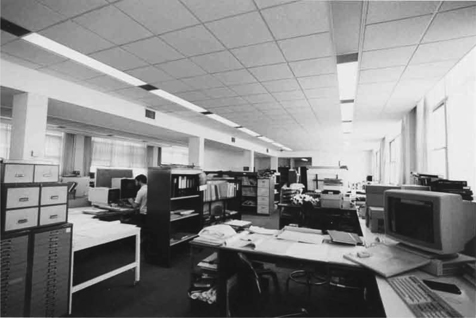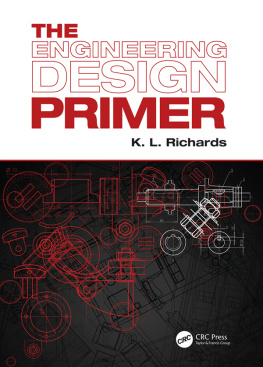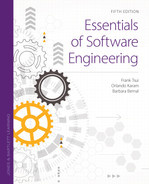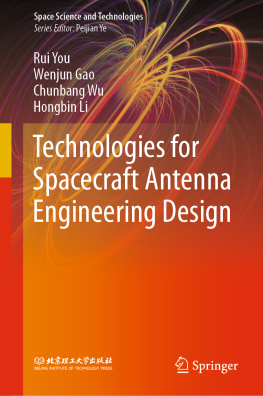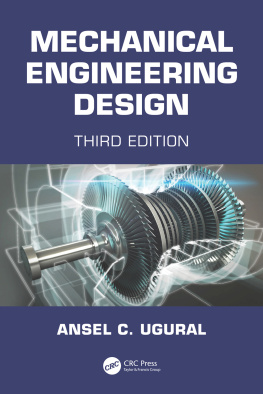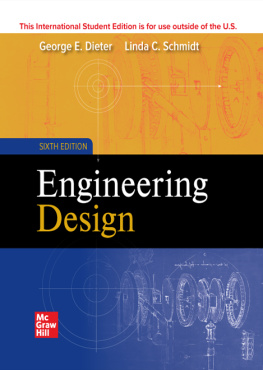The Engineering Design Primer
CRC Press
Taylor & Francis Group
6000 Broken Sound Parkway NW, Suite 300
Boca Raton, FL 33487-2742
2020 by Taylor & Francis Group, LLC
CRC Press is an imprint of Taylor & Francis Group, an Informa business
No claim to original U.S. Government works
Printed on acid-free paper
International Standard Book Number-13: 978-0-367-21013-7 (Hardback)
This book contains information obtained from authentic and highly regarded sources. Reasonable efforts have been made to publish reliable data and information, but the author and publisher cannot assume responsibility for the validity of all materials or the consequences of their use. The authors and publishers have attempted to trace the copyright holders of all material reproduced in this publication and apologize to copyright holders if permission to publish in this form has not been obtained. If any copyright material has not been acknowledged, please write and let us know so we may rectify in any future reprint.
Except as permitted under U.S. Copyright Law, no part of this book may be reprinted, reproduced, transmitted, or utilized in any form by any electronic, mechanical, or other means, now known or hereafter invented, including photocopying, microfilming, and recording, or in any information storage or retrieval system, without written permission from the publishers.
For permission to photocopy or use material electronically from this work, please access www.copyright.com (http://www.copyright.com/) or contact the Copyright Clearance Center, Inc. (CCC), 222 Rosewood Drive, Danvers, MA 01923, 978-750-8400. CCC is a not-for-profit organization that provides licenses and registration for a variety of users. For organizations that have been granted a photocopy license by the CCC, a separate system of payment has been arranged.
Trademark Notice: Product or corporate names may be trademarks or registered trademarks, and are used only for identification and explanation without intent to infringe.
Library of Congress Cataloging-in-Publication Data
Names: Richards, Keith L., author.
Title: The engineering design primer / authored by K.L. Richards.
Description: Boca Raton, FL : CRC Press/Taylor & Francis Group, 2020. | Includes bibliographical references and index.
Identifiers: LCCN 2019040887 (print) | LCCN 2019040888 (ebook) | ISBN 9780367210137 (hardback ; acid-free paper) | ISBN 9780429264917 (ebook)
Subjects: LCSH: Product design. | Engineering design.
Classification: LCC TS171 .R48 2020 (print) | LCC TS171 (ebook) | DDC 658.5/752dc23
LC record available at https://lccn.loc.gov/2019040887
LC ebook record available at https://lccn.loc.gov/2019040888
Visit the Taylor & Francis Web site at
http://www.taylorandfrancis.com
and the CRC Press Web site at
http://www.crcpress.com
Contents
The philosophy behind the engineering design primer is to introduce student engineers to the world of engineering design. Most student engineers start in the drawing office as draughtsmen and the majority stay there for the duration of their working lives with little thought of progressing into design engineering. From the authors experience, the drawing office lays a very good foundation for a career in design and allows the student to explore the many facets of design.
The first part of the book introduces the student to the workings of the drawing office together with the working principles of producing a drawing having sufficient detail to enable the part to be manufactured. covers the principles of the design process followed by the design specification or PDS. This is the singular most important document in the design process as it lays down the definition of the design in so far as what the company will produce and most importantly what the customer is expecting.
covers Design for X discussing such items as manufacture, reliability, robustness, maintainability and serviceability. Life cycle costing is also discussed in this chapter.
Quality is discussed in Chapters 6 and 11. It is important for the producer that the customer has the utmost confidence that the product they buy will meet all their expectation.
I make no apology for discussing probabilities and engineering statistics as these items are important when discussing reliability.
The book is rounded off with chapters on material selection, mathematical modelling and configuration management, the later covering change controls. Communication is an important attribute for the budding designer to stand up and confidently and clearly to put his case across for the adaptation of his/her design.
The author wishes the readers every success in their respective design careers and hopes it will provide them many years of employment as, it has for him.
Keith L. Richards is a retired mechanical engineer with industry experience of over 55 years. He served an indentured apprenticeship with BSA Tools that manufactured a wide range of machine tools including the Acme Gridley, a multi-spindle automatic lathe built under licence, and single-spindle automatic lathes; these were built in Britain and widely exported all around the world.
On leaving the BSA, he served as a freelance engineering designer in a wide range of industries, including aluminium rolling mill design, industrial fork lift trucks and was a lead engineer for the mooring system for the Hutton tension leg platform. In later years he became more involved in stress analysis that led to working in the aerospace industry covering landing gear and environmental control systems for both military and commercial aircraft and trailing wing components for the Airbus A380.
Over the last few years the drawing office has seen a massive revolution. Digital draughting has replaced the original method of paper and manual drawing, and alongside this major change there has been a technological revolution in the way drawing prints are now processed and the way data is now transferred to the multi-axis machining centres on the shop floor.
Drawing offices used to be quite noisy with general chatter and heated discussions, now all this has been replaced by a quiet environment with only the clatter of keyboards to be heard. Any major discussions are carried out in side offices to the main drawing area.
show typical drawing offices from 1900 to the present day, and the changes that have taken place can be seen. This has been reflected across the engineering industry in the United Kingdom.

FIGURE 1.1
A drawing office in early 1900s.
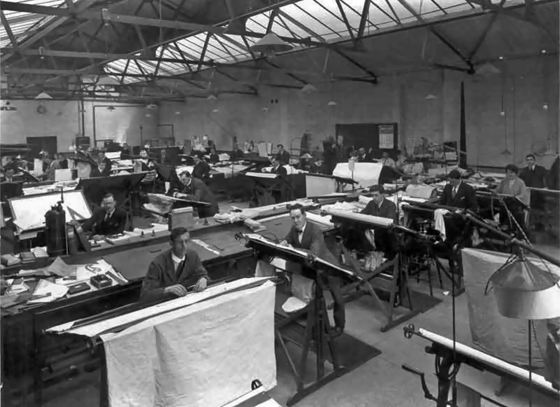
FIGURE 1.2
1923 drawing office.
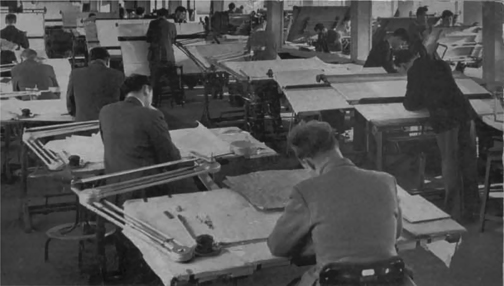
FIGURE 1.3
1963 drawing office.
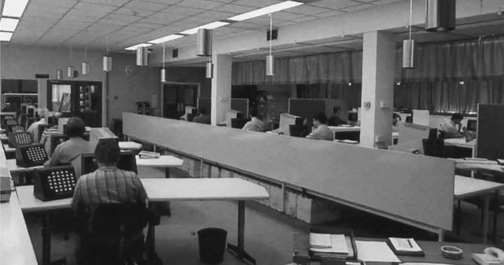
FIGURE 1.4
A typical computer-aided design (CAD)/computer-aided manufacturing (CAM) drawing office in 1986.
